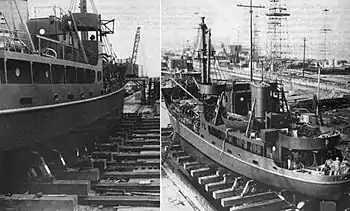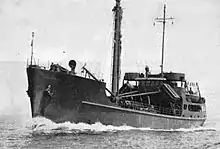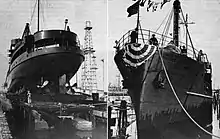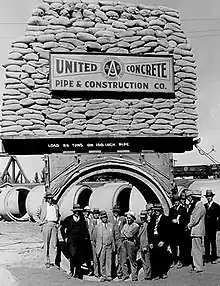United Concrete Pipe Corporation




United Concrete Pipe Corporation main construction was of main water pipeline lines, building concrete bridges, concrete roads, and foundations for buildings. United Concrete Pipe was established in 1919 in Ventura, California, by (Thomas) Tom P. Polich. In 1924 Steve Krai and B. J. Ukropina became partners with Polich. Tom Polich was born on March 22, 1888, in Serbia and came to the US in 1905. Polich worked for a concrete company in Van Nuys, California, before starting his own company. His first contact was installing a irrigation system in Tuttle, California. In the 1930s under the Works Progress Administration the company grew to nine plants and became a general contractor, not just a pipe company. Plants were in California, Texas and New Mexico. In 1953 the three started a new parallel joint venture Ukropina-Polich-Krai of San Gabriel, a general contractor company. United Concrete Pipe Corporation headquarters was at 85th St. and Vermont Ave., Los Angeles, California. One Works Progress Administration project was the Wawona Tunnel built in 1933.[1] In 1937 United Concrete Pipe completed a Works Progress Administration project the Mad River Water Supply Project in Eureka, California. United Concrete Pipe Corporation last plant closed in 1994, at Riverside, California.[2][3][4][5][6][7]
In 1943, United Concrete Pipe established a shipyard division in Long Beach, California, to build small coasters ships for the US Army under the Emergency Shipbuilding Program. The shipyard of United Concrete Pipe was in Long Beach at breath 83, at the north side of channel 2, at the entrance to the channel. Unique to the boatyard was the assembly line railway the ships were built on. As the boat was built it would move down the rail track towards the water. The steel for the shipyard was shaped by the United Concrete Pipe Baldwin Park, California, plant. The Army ships were 176-foot, a beam of 30 feet, a draft of 8 feet, and were 935 tons loaded. Power was from two General Motors Clevland diesel engine each with 500 hp. The first ship was complete on March 23, 1944.[8][9][10][11][12]
Ships
| Name | Owner | Type | Tons | Length | Built | Notes |
|---|---|---|---|---|---|---|
| FS 387 | US Army | Coastal Freighter | 560 | 176 | May-44 | |
| FS 388 | US Army | Coastal Freighter | 560 | 176 | May-44 | |
| FS 389 | US Army | Coastal Freighter | 560 | 176 | Jun-44 | To the Philippines as Neptuno |
| FS 390 | US Army | Coastal Freighter | 560 | 176 | Jul-44 | To USN 1951 as Deimos (AKL 40), to Korea 1951, scrapped 1960 |
| FS 391 | US Army | Coastal Freighter | 560 | 176 | Jul-44 | To USN 1947 as Hewell (AG 145), later AKL 14, sold 1960 |
| FS 392 | US Army | Coastal Freighter | 560 | 176 | Aug-44 | |
| FS 393 | US Army | Coastal Freighter | 560 | 176 | Sep-44 | To the Philippines as Basilan |
| FS 546 | US Army | Coastal Freighter | 560 | 176 | Sep-44 | To China as Hai Who |
| FS 547 | US Army | Coastal Freighter | 560 | 176 | Oct-44 | To USN 1951 as Renate (AKL 42), to Korea 1951, scrapped 1960 |
| FS 548 | US Army | Coastal Freighter | 560 | 176 | Nov-44 | To USN 1950 as AKL 32, struck 1961 |
| FS 549 | US Army | Coastal Freighter | 560 | 176 | Nov-44 | To the Philippines as Corregidor |
| FS 550 | US Army | Coastal Freighter | 560 | 176 | Dec-44 | To the Philippines as Bohol |
| Tangier Island | Omega Protein | Fishing Vessel | 538 | 166 | 1944 | |
| Joan of Arc | Fishing Vessel | 131 | ca. 1946 | 1 shaft direct drive 805 hp FM 37-E-14 7cyl. 2 225 hp Atlas-Imperial 6cyl. aux[13] | ||
| Star Kist | ||||||
| Courageous | ||||||
| Santa Barbara | ||||||
| Alaska | Diehl Trust | Fishing Vessel | 221 | 94 | 1947 |
References
- "Wawona Tunnel, Wawona Road through Turtleback Dome, Yosemite Village, Mariposa County, CA | Library of Congress". Loc.gov. Retrieved 2021-03-11.
- Mad River Water Supply Project
- Tom P. Polich, bio, Tuttle, California, Merced County, California
- Merced County Bios
- Want add United Concrete Pipe Corporation
- B. J. Ukropina, Bio
- California highways and public works
- "The Log - Google Books". July 1944. Retrieved 2021-03-11.
- "United Concrete Pipe". Shipbuildinghistory.com. 2015-05-20. Retrieved 2021-03-11.
- CORREGIDOR (IMO 5080457) - General Cargo. "CORREGIDOR (IMO 5080457, General Cargo) - Ship Details and Current Position". Vessel Tracking. Retrieved 2021-03-11.
- The Log, Volume 39, July 1944
- Tuna Boat by United Concrete Pipe Corporation
- "New Tuna Clipper Performs Like Veteran". Pacific Marine Review. July 1946. p. 81.